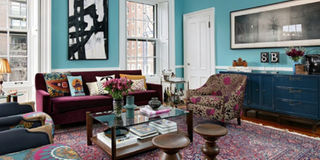Bringing contrast into your interior

Mix-matching the colours in your interior will make it warmer and more attractive. Courtesy photos
What you need to know:
Mix-matching colours brightens and brings energy into a home. Here is how to do it right.
The type of furniture you choose and the accessories say a lot about you. The colour factor in furnishing your home even gives a better description of who you are, architectural designs and surroundings.
Imagine if you walked into a room and every surface was covered with the same colour shade and material. Such a room would be very boring and the eyes will naturally wander off to a place that is more engaging.
According to Monica Tino, an interior designer at Divahz Interior Designers, colours affect your daily lives and each colour impacts your personalities and moods differently. Therefore, before furnishing your home, it is important to understand how to mix and match your colours properly. There are several factors to consider before you mix and match colours to ensure a cohesive design as it gives you a chance to showcase multiple design elements at the same time.
Be different
She says: “Tones and shades arranged in the same vertical lines will always complement each other. Choose colours based on the style of your home and do not be afraid to make unusual combinations because being different in terms of selecting patterns and colours are not a bad thing.”
Keep in mind that it is probably a good idea to stick to similar undertones. Any colour combination will look good as long as the base colour is similar. She advises use of neutral colours to paint your interior but paint the ceiling slightly paler than the walls to make the rooms seem brighter.
Use patterns
When it comes to mixing and matching, patterns are very important says Andrew Mbabazi, an interior designer at Ayodele Interiors, because you can use them to infuse both colour and visual impact into your space. You can incorporate them anywhere in the room from the floor, to wall coverings, to accessories like throw pillows.
“Successfully mixing patterns involves combining different prints that have a few common threads,” says Mbabazi.
It is important to keep prints and patterns within the same colour theme to give the room a cohesive look. Neutral colours are more recommendable here and ensure to physically space the patterns around the room so that no section ends up looking so stimulating than the others.”
Note also that after a certain point, too many points of visual interest become overwhelming. Spaces that are well designed strike a balance between these two extremes to create a harmonious look.
Arrangement
Mixing and matching colours (contrast) is all about that comfort you get when you walk into the room. Having knowledge about how colour works would help you infuse different patterns and being able to balance them depending on the amount of space.
Tino remarks that keeping in mind that dark colours tend to have more visual weight than light colours, arrangement of the items in the room after choosing the colours is important. You may choose to have them symmetrical, where everything mirrors each other on both sides of the room. She says: “The asymmetrical arrangement is where you want to keep both sides equally afloat regardless of how much is on either side. When the arrangement is radial, you use a centre focal point and create a circular ambiance with your furniture and the other items you may want to place in the room.”
Consider proportions
While matching colours, it is important to consider the proportions because harmony establishes function, mood and personality. Consider which colours you are using together and how much of each. This is usually driven by the architecture design you chose and the size of the room.
Using two colours in equal measure may be effective but a better sense of balance can be achieved by using more of one colour and less of another at a time.
Do a trial
Even when someone suggests colours for your house furnishings, it is important that you choose what you think will suit you because you are the one who is going to live in the house not the other person.
Mbabazi says it is recommendable that you use samples before making your final decision on mixing and matching colors.
“Colours have different tones depending on the time of day and different lighting situations and before committing to colours, it is important to hold up the colour swatches at different times during the day, so that whatever the lighting condition, you will be content with your colour choices,” he advises.
“Be careful however, says Mbabazi, “as mixing and matching styles needs to be carefully planned to avoid your home or room looking cluttered. You may have found so many pieces and you like all of them but remember that the size of your room must scale your furniture and décor.”
Choosing the right colours
Layering
But how do you make the right choices? The secret to getting it right is layering. You should start with a neutral backdrop and build on colour carefully by adding bolder colours through accessories and art. Your wall colours should form your backdrop, but keeping these neutral doesn’t mean painting them a bland and boring shade. You can create a neutral version of practically any colour and can go either very light or very dark. Think greys, caramels and sandy tones, all of these work in any version from light to dark as a neutral backdrop that you can combine with any other accent colour.
irishtimes.com




